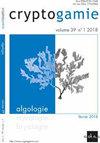泥炭地硅藻群落的时空动态
IF 1.5
4区 生物学
Q3 MARINE & FRESHWATER BIOLOGY
引用次数: 3
摘要
摘要/ Abstract摘要:本研究对捷克泥炭地两种微生境类型(Sphagnum periphyton和epipelon)硅藻群落的时空动态进行了研究。分析了大尺度(立地间)和小尺度(两个微生境间)硅藻群落结构及其多样性指数随时间的变化。结果表明,硅藻群落在大尺度上有明显的空间格局,但在小尺度上没有明显的空间格局,而且只有有限的季节动态。在大尺度上,不同地点硅藻群落的显著差异与地理位置和环境条件(pH和电导率)有关。微生境类型对采样点的影响显著;在小尺度上,其他因子与物种数据的关系不重要。研究结果表明,硅藻多样性和群落结构是反映生态异质性的良好指标,具有较高的空间和环境变异性。然而,使用传统硅藻物种很难检测或隐藏环境条件的细微差异。本文章由计算机程序翻译,如有差异,请以英文原文为准。
Temporal and Spatial Dynamics of Diatom (Bacillariophyceae) Communities in a Peatland Area
Abstract
This study was conducted to simultaneously investigate the spatial and temporal dynamics of diatom communities inhabiting two microhabitat types (Sphagnum periphyton and epipelon) in a peatland area of the Czech Republic. The changes in diatom community structure and corresponding diversity indices at both large (i.e., variation between sites) and small (i.e., variation between two microhabitats) scales were assessed through time. The results indicated clear spatial patterns at large, but not at small scale, and only limited seasonal dynamics in the diatom community. At the large scale, significant differences in diatom communities among sites were associated with both geographic position and environmental conditions (pH and conductivity). A significant effect of microhabitat type was detectable within sampling sites; the relationship between other factors and species data was not important on a small scale. The results of this study showed that both diatom diversity and community structure are good indicators of ecological heterogeneity associated with relatively high spatial and/or environmental variability. However, subtle differences in environmental conditions are hardly detectable or hidden using traditional diatom species.
求助全文
通过发布文献求助,成功后即可免费获取论文全文。
去求助
来源期刊

Cryptogamie Algologie
生物-海洋与淡水生物学
CiteScore
2.60
自引率
7.70%
发文量
11
审稿时长
>12 weeks
期刊介绍:
Cryptogamie is a fast-track and peer-reviewed journal of international scope publishing in English only. It accepts original papers and review articles on the taxonomy, biology and ecology of all cryptogams. An issue of Cryptogamie may be devoted to a single topic, under the responsibility of guest editor(s). All articles published in Cryptogamie are compliant with the different nomenclatural codes. A copyright assignment will be signed by the authors before publication.
Cryptogamie, Algologie accepts articles on systematics as well as ecology and evolution of any kind of algae (including Cyanobacteria).
 求助内容:
求助内容: 应助结果提醒方式:
应助结果提醒方式:


